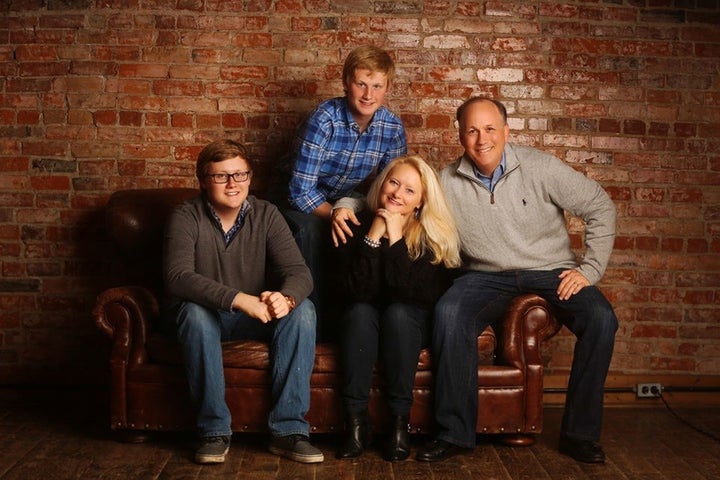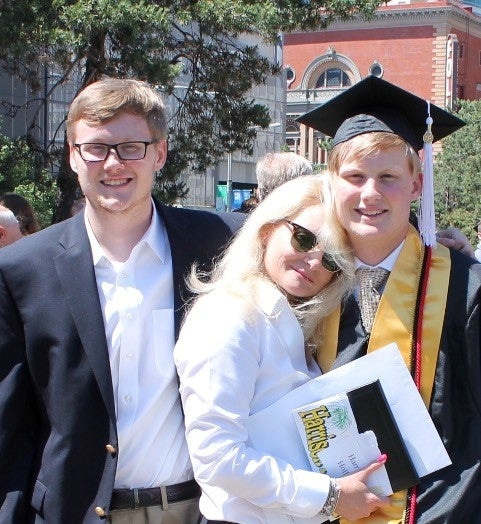When Richmond Carson became a manager of Carma restaurant in Leawood, Kansas, his mom recommended he learn some lifesaving skills, including CPR.
“You never know when you might need it,” she said.
With a setup like that, you can probably guess where this story is headed. And you’re right, for the most part. But as with any good tale, this one has many layers – twists and turns, drama and tension, coincidences and lessons, all connected by a mother’s wisdom.
***
It started on a Saturday in January 2015.
Nancy Holland spent the day grocery shopping, bathing her boxer puppy, Lincoln, and getting her nails painted in her favorite polish, a pink-red tone called Dutch Tulips. She kept so busy that she and her husband, Jim, were a few minutes late to dinner with their neighbors.
Carma wasn’t among their go-to restaurants, which is why they picked it. Jim wanted to break from their routine and remembered the delicious rigatoni the one time they ate there.

Nancy Holland with her husband Jim and their sons Dane (seated) and Chance.
The hostess, Bria, seated them in the main dining room near the bathroom. Nancy asked if another table was available and Bria took them to the private dining rooms.
A few bites into her salad, Nancy pushed her plate aside. She said, “I’ll be right back,” and walked to the bathroom.
Another woman already was in there. She soon ran out screaming, “Some woman passed out in the bathroom!”
***
Richmond found Nancy face-down, drenched in blood from her nose and tongue, casualties of her smashing into the floor.
Fearing a neck injury, he didn’t want to move her. But she also didn’t have a pulse. The 911 operator insisted he flip her over because getting her breathing mattered most.
“Do you know CPR?” asked the woman from the bathroom, her name never captured, only her voice on the 911 tape.
Richmond provided CPR until paramedics arrived, keeping blood circulating. The first responders also brought an automated external defibrillator, or AED, because the restaurant didn’t have one. It took three jolts to restart Nancy’s heart.
At their secluded table, Jim and friends were oblivious. They saw lights from a fire truck but didn’t know they were answering a call at this restaurant.
Nancy had been gone about 10 minutes when the other woman in their group went to check on her. Jim ended up arriving to see his wife’s bloody body popping off the ground from the force of the AED.
Paramedics loaded Nancy into an ambulance and Jim got into a police car that would follow the ambulance. Only, the ambulance didn’t move.
A police officer went to check on the delay. Nancy’s heart had stopped again.
***
Nancy had no family history of heart disease … at least, not until three months before, when her dad suffered the kind of heart attack so severe it’s dubbed “the widow maker.”
Perfect response by paramedics saved his life. It included a helicopter rescue from his home in rural Arkansas.
Nancy wasn’t having a heart attack, though.
When a heart stops suddenly, without symptoms, it’s almost always cardiac arrest. Often considered synonymous with a heart attack, they are different. A heart attack is like a plumbing problem, cardiac arrest is more of an electrical malfunction.
But Nancy had something in common with her dad. Thanks to Richmond and the first responders, she, too, received textbook care.
It also helped that the hospital was three blocks away.
***
The source of Nancy’s problem was a blood clot that likely formed outside her heart. When it got there, it acted like a trip wire, shutting off the heart’s electricity and causing her to collapse.
She could’ve died, especially if she’d been in that bathroom alone. The clot, meanwhile, kept going until settling at the top of her heart.
It’s still there. It probably won’t go anywhere, either. Doctors are monitoring it and are confident it poses no threat. She’s 47 and in good physical condition, her risks further minimized by lifestyle choices: she doesn’t smoke, rarely drinks and exercises regularly.
Back at the hospital on Jan. 17, 2015, they weren’t taking any chances. After discovering the problem during a cardiac catheterization procedure, doctors put Nancy into a medically induced coma and lowered her body temperature to help preserve her organs as she recovered from the trauma.
The coma lasted for two days. She was in the hospital 10 more.
About two weeks later, friends threw a dinner party. At Carma, a name that now carried added meaning.
***
During those first few weeks of her second chance at life, Nancy’s mind raced.
“You’re scared to walk up the stairs, scared to walk to the mailbox, scared to get off the couch,” she said. “You’re thinking, `What did I do to bring on the clot to begin with?’”
She also thought about what she almost lost: Jim and their sons Dane, then a senior in high school, and Chance, a sophomore at the time.
“You make these deals with God, `If you can only give me a couple of years to get my kids to college so they can start their lives and not have to come home to an empty house, you can take me then,’” she said.
Returning to Carma pulled her from her emotional funk. What really did it was meeting Richmond – and his mother, Mari, a respiratory therapist.
Nancy and Richmond hugged and she cried while whispering thanks. It set a template that repeats every Christmas and Easter, birthdays and anniversaries, Valentine’s Day and any day that’s special. They celebrate together in person when they can, by text if they can’t.
Nancy missed Richmond’s wedding – to Bria, the hostess who’d seated the Hollands on that fateful night – because it was at the exact time as Dane’s high school graduation. Nancy and Jim were at the hospital the night the couple’s first baby arrived, a daughter named Avaya.
Chance graduated from high school a few weeks ago. Nancy’s eyes remained dry throughout the festivities. Until Richmond arrived at their party.
“You saved me, you breathed life back into my body and you gave me the gift of tomorrow,” she whispered between sobs. “I’ve gotten to see proms and first loves, I’ve gotten to take my children off to college, all because of you.”

Richmond, Nancy and Avaya at the girl's first birthday party, on June 10.
***
Everyone should know Hands-Only CPR. After all, there are only two steps. When you see a teen or adult collapse:
- Call 911.
- Push hard and fast in the center of the chest, preferably to the beat of the disco song “Stayin’ Alive.”

Those are the basics. We also encourage everyone to extend their training to include conventional CPR and how to use an AED. Using mouth-to-mouth breathing can provide oxygen to vital organs, preventing brain damage.
For employers, it only makes sense to provide their staff this vital training. In addition to protecting their greatest resource (their employees), the session could be a fun, team-building experience.
Two new surveys commissioned by my organization, the American Heart Association, show that most workers lack access to CPR and First Aid training, and half couldn’t locate an AED at work. All this despite reports showing there are 10,000 cardiac arrests in the workplace each year. It’s why the AHA is launching a campaign to promote First Aid, CPR and AED training in the workplace, as well as expanded access to AEDs. (One more stat: 350,000-plus cardiac arrests that occur outside of hospitals each year with more than 100,000 occurring outside the home. That’s 11 every hour.)
Some workplaces are ahead of the curve. Like the Coast Guard, where Nancy’s dad worked. He was trained in CPR in the early days of the national rollout and used it on a stranger in Manhattan in the early 1980s. He revived the man in time for paramedics to take him to the hospital.
In the late 1990s, Nancy worked for the Kauffman Foundation, and her entire office received training in lifesaving skills.
Then there’s Fisher Phillips, the law firm where Jim Holland is the managing partner of the Kansas City office.
Since August 2015, the company has installed AEDs in all 32 offices across the country and offered CPR training to all 700 employees.
It’s called the “Richmond Initiative.”
Nancy has put her devotion into action, too, going from honoree to board member of the local chapter of the HeartSafe Foundation, which is devoted to awareness and education about Hands-Only CPR and AEDs.
“Training takes merely a few minutes of your life but it can be the difference between life and death for someone else,” Nancy said. “Like Richmond’s mom said, you owe it to others to have this skill set.”

Nancy with her sons at Chance's recent high school graduation.

